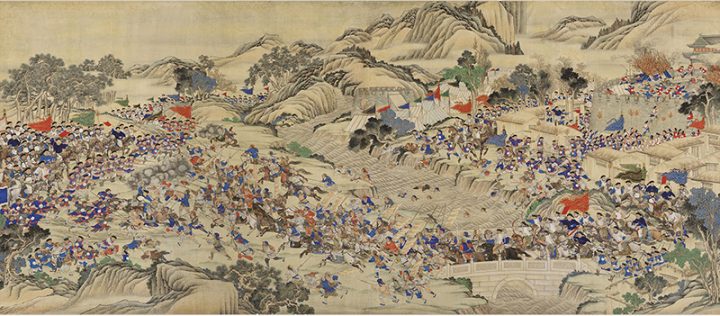L’arte della Guerra
testo di Walter Sobchack

A scene of the Taiping Rebellion, 1850–1864. Wu Youru, 1886.
孫子兵法 (L’arte della Guerra) è un trattato di strategia militare attribuito al generale 孫子 (Sunzi). L’originale più antico rinvenuto risale al III secolo A.C., anche se lo si valuta come scritto almeno tre secoli prima.
Il libro comincia con un’attenta valutazione di base delle forze in campo, per proseguire sui consigli per ciò che concerne la conduzione dei conflitti in generale, le disposizioni, l’adattamento alle condizioni del nemico, del meteo e del terreno, fino all’uso delle spie a proprio vantaggio.
Quello che stupisce ancor oggi è la stretta correlazione tra le strategie descritte e la filosofia di vita. Sunzi si muove analizzando ogni variabile e non disdegnando anche la ritirata o la rinuncia al conflitto quando le condizioni non sono note e favorevoli o quando non è necessario. Il suo obiettivo sarà sembre conquistare il nemico intatto e senza nessuna perdita per avere il massimo beneficio dal bottino. In ogni momento il comandante e il suo esercito si trovano in armonia: i soldati sono trattati con umanità ma anche con disciplina, soppesando ricompense e punizioni.
THE ART OF WAR
text by Walter Sobchack; translations by Laura Dumbrava

A scene of the Taiping Rebellion, 1850–1864. Wu Youru, 1886.
孫子兵法 (“The Art of War”) is a military treatise attributed to General Sunzi. The original ancient one dates back in the third century AC, although it can be evaluated as written three centuries before. The book starts with an attentive basic evaluation of forces and then continues with pieces of advice for what concerns the conduction of conflicts, in general, from dispositions and adaptation of the enemy, weather and field to the use of spies as an own advantage.
What is more surprising nowadays is the close connection between the described strategies and the philosophy of life. Sunzi highlights any variable without disdaining the possibility of retreat or withdrawal from the conflict when the conditions are not favorable or when it is not necessary. His objective aims always to the conquest of enemy, in an intact manner and without losing, in order to have the maximum benefit. At any time, the commander and his army are in peace with each other: the soldiers are treated with humanity and discipline, weighing both reward and punishment.
